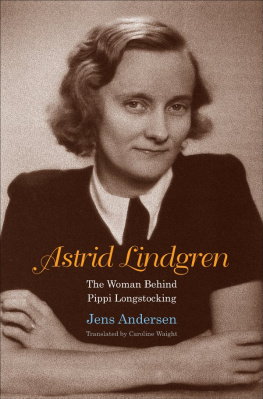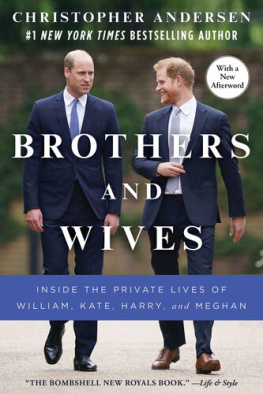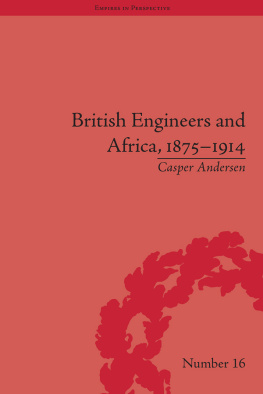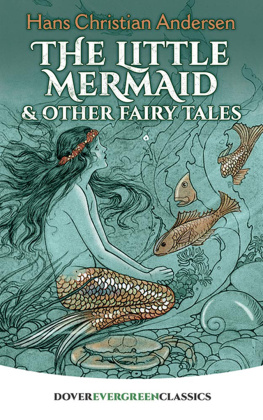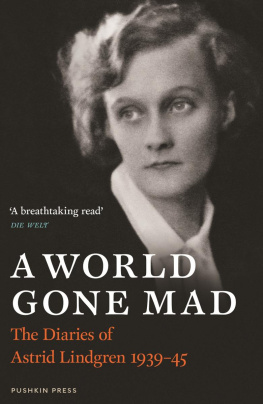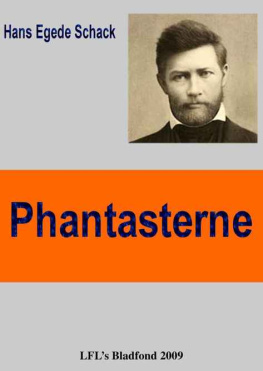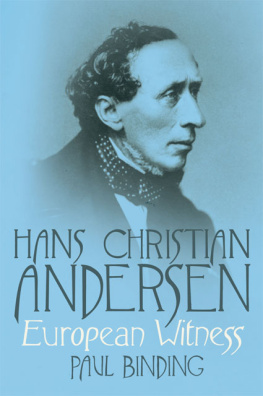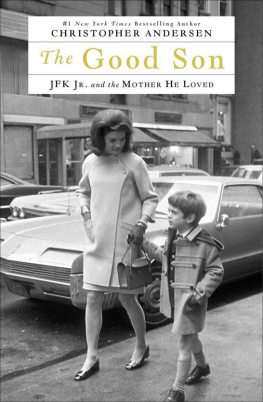Astrid Lindgren

DANISH ARTS FOUNDATION
Published with assistance from the Danish Arts Foundation.
Published with assistance from the foundation established in memory of Philip Hamilton McMillan of the Class of 1894, Yale College.
Photos on pages 165 and 250, Saltkrkan AB. All others, private ownership/Saltkrkan AB.
English translation copyright 2018 by Yale University. All rights reserved. Originally published as Denne dag, et liv. Copyright 2014 by Jens Andersen and Gyldendal, Copenhagen. Published by agreement with Gyldendal Group Agency.
This book may not be reproduced, in whole or in part, including illustrations, in any form (beyond that copying permitted by Sections 107 and 108 of the U.S. Copyright Law and except by reviewers for the public press), without written permission from the publishers.
Yale University Press books may be purchased in quantity for educational, business, or promotional use. For information, please e-mail sales.press@yale.edu (U.S. office) or sales@yaleup.co.uk (U.K. office).
Set in Bulmer type by IDS Infotech, Ltd.
Printed in the United States of America.
Library of Congress Control Number: 2017940326
ISBN 978-0-300-22610-2 (hardcover : alk. paper)
A catalogue record for this book is available from the British Library.
This paper meets the requirements of ANSI/NISO Z39.48-1992 (Permanence of Paper).
10 9 8 7 6 5 4 3 2 1
What the meaning of life isntthat I do know. Scraping together money and possessions and things, living a famous persons life and appearing in the gossip pages of weekly magazines, being so afraid of loneliness and silence that you never get to take a step back and think: what am I doing with my short time on this earth?
Astrid Lindgren, 1983
Contents
Acknowledgments
IT TAKES TWO TO WRITE A BIOGRAPHY : the person writing it and the person being written about. In fact, there are usually lots of other people involved in the process too, all of whom shape the final work. This includes writers of previous books and articles about the biographers subject, which may prove very useful to a later author. In the list of sources at the back of this book, you can find references to all of the books, articles, magazines, and websites about Astrid Lindgrens work to which I am indebted, accompanied by an index and an overview of Astrid Lindgrens works published in Danish.
I owe a huge thank-you to everyone who helped me track down other types of material: first and foremost to Astrid Lindgrens bibliographer Lena Trnqvist, a tireless source of advice and information. She taught a Dane to navigate Astrid Lindgrens archive at the National Library of Sweden, which was entered onto UNESCOs Memory of the World register in 2005. Thanks are also due to Britt Almstrm, stenographer at the Swedish Riksdag, who helped me decipher some of Astrid Lindgrens notebooks written in shorthand. Likewise, Im deeply grateful for the support I received from Anna Eklundh-Jonsson at the Regional State Archives at Vadstena, Bruno Svindborg, research librarian at the National Library of Denmark in Copenhagen, and Elin Algreen-Petersen, senior editor for childrens and young adults books at Gyldendal.
When working on a biography, youre always reliant on other peoples goodwill, generosity, and willingness to contribute their specialized knowledge and skills. Thanks are due to Tom Alsing, Barbro and Bertil Alvtegen, Urban Andersson, Ida Balslev-Olesen, Malin Billing, David Bugge, Ning de Coninck-Smith, Hlne Dahl, Gallie Eng, Belinda Erichsen, Jens Fellke, Jacob Forsell, Lena Fries-Gedin, Eva Glistrup, Klaus Gottfredsen, Stefan Hilding, Jesper Hgenhaven, Sven Reiner Johansen, Anneli Karlsson, Kerstin Kvint, Jeppe Launbjerg, Kathrine Liller, Annika Lindgren, Jrn Lund, Carl Olof Nyman, Nils Nyman, Elsa Trolle nnerfors, Johan Palmberg, Gunvor Runstrm, Anja Meier Sandreid, Lisbet Stevens Senderovitz, Margareta Strmstedt, Helle Vogt, and Torben Weinreich.
A special thank-you goes to Saltkrkan AB for its practical and technical support, not least with many of the illustrations in the book, to Kjell-ke Hansson and the staff at Kulturkvarteret Astrid Lindgrens Ns in Vimmerby, a cultural center dedicated to Astrid Lindgren, and to Jakob Nylin Nilsson at Vimmerby Library. Thank you to the Danish Astrid Lindgren translator Kina Bodenhoff, to Jenny Thor at the Gyldendal Group Agency, and to my editors, Vibeke Majnlund and Johannes Riis.
Finally, Im grateful to the National Arts Foundation, the Gangsted Foundation, and the Danish-Swedish Arts Foundation for financial support, and to my indefatigable first reader, Jette Glargaard. And last but not least, thanks are due to Karin NymanAstrid Lindgrens daughterwho thought writing this book was a good idea. Without her interest, insight, and active cooperation in the form of a long series of conversations and correspondence over the past year and a half, it would not have been possible.
Jens Andersen
Copenhagen, August 2014
Astrid Lindgren
ONE
Fan Letters to the Author
BUSINESS THRIVED AT THE POST OFFICE on the corner of Dalagatan and Odengatan over the course of the 1970s, and it was all due to one elderly woman. She looked like any other old lady you might see on the street, in the park, at the produce market, or at the tearoom in the area of Stockholm known as Vasastan. Every day for many years, a handful of letters was dropped through the slot at this old ladys house, and on her milestone birthdays in 1977, 1987, and 1997, the postman had to ring the bell at 46 Dalagatan to deliver sacksful of parcels and letters postmarked from across the world. Once the many notes had been read and answered, they were carried up to the attic in cardboard boxes that contained not only cheerful cards and colorful childrens drawings but also gilt-edged greetings from statesmen and royals, as well as more ordinary letters from people who just wanted an autograph, or were requesting financial help or moral support for some sort of political cause.
The vast majority of letters addressed to Astrid Lindgren over the years, however, were first and foremost expressions of spontaneous enthusiasm and admiration, although their authors often took the opportunity to slip in a question or two. Not all of them were quite so innocent as the one posed by a Swedish kindergarten class, who wanted to know whether horses could really eat ice cream, or Kristina from Jfllas question about how Pippi Longstockings dad in the television series was able to send a message in a bottle while stuck in jail. There was also a huge number of more self-aware, grown-up queries among the piles of mail: a tinsmith from Kalmar by the name of Karlsson requested permission to call his firm Karlsson on the Roof, a forester in Jmtland wondered whether the nature-loving writer might be interested in a few hectares of pine woodland, and a man in prison for murdering his wife asked whether Lindgren would like to write his life story.
More than a few of the seventy-five thousand letters received by the popular, well-known author right up till her death in January 2002, letters that today are held in the Astrid Lindgren archive at Swedens National Library in Stockholm, were highly personal in nature. When it came to Pippi and Emils mother, people evidently paid little attention to the boundary between public and private. As she grew older, Astrid Lindgren came to be perceived as Scandinavias kloka gummaa nearly mythical kind of wise woman or healer, a spiritual adviser to whom you could open your heart and pour out your troubles. One woman, for instance, wrote asking Astrid to mediate a bitter dispute with her neighbors, while another inquired how best to cope with her burdensome old mother. A third female letter writer deluged the prosperous childrens book author with begging letters: seventy-two in total, each containing new and detailed requests for financial help with such issues as buying new glasses, fixing the car, paying contractors bills, and settling gambling debts. An Austrian man who had been wanting a new house for years wrote from abroad to ask whether Pippis mother might give him a large sum of money in dollars to build his dream home, Villa Villekulla. For forty years, one Danish father used to send long Christmas letters, reporting all sorts of family news and enclosing a few of his childrens home-baked treats. Meanwhile, the Stockholm suburb of Hsselby was the source of a veritable bombardment of letters proposing marriage: they came from an older man who threw in the towel only when the widowed Mrs. Lindgrens publisher intervened and threatened the importunate suitor with a restraining order.
Next page
